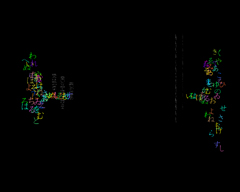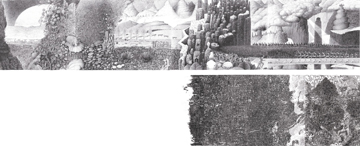 The total count of the combination of 47 IROHA letters amounts to a factorial of 47 (47x46x45......3x2x1), that is an astronomical 60 digit number that starts 2586 and ends 0, but it is limited and is only one number. I created 47 Jibo Uta freely inspired by theme and region this time. Unfortunately, I need to admit that my Jibo Utas are incomplete and immature, and it is certain that they already exist possibly among the factorial of 47 combinations from the beginning. In that respect, we can say that making Jibo Uta is not a creation but a work of extract. The anagram was dealt with as a subject matter by Marcel Duchamp who is referred to as the founder of contemporary art, and he intertwined it with mirrors and chess that are his other main subjects in the field of fine arts. While I dealt in perspective image and mirrors as major subjects in the scroll that I have drawn for 17 years, it is two sides of the same process for me to draw the scroll and to extract "IROHA pangram". Pangram is basically a mirror image and phantasmagoric strange world where one letter to another is transformed and replaced (reflected to change). Involvement in "Jibo Uta" can be the awesome conduct of exposing a taboo somehow. However, I frankly feel that it is naturally revealed as a requiem for the people who were involved in such a historic movement this time. PROFILE  The "Life Scroll" (drawings on scroll), started in 1991, is Chiba's most central artistic work. He has been adding drawings on the Life Scroll in principle everyday since then, and it has now become about 14 meters long. His transitional changes in expression and changes between his late 30s and the present day are drawn on the scroll. He is planning to eventually bring his life in line with the scroll. The more he draws, the larger his expression space which occupies the scroll. Consequently, it has become gradually distanced from the momentary and bodily visual expression of modern painting. Rather, he has been creating a space loaded with contradiction, by consciously contrasting Western perspective expression and mirror projection using water surfaces, with the Eastern contra-perspective, birds-eye view and isometric projection method. The process of his work has also been recorded as photocopies(1991-2004) and scannings (2004-) on a daily basis, and he is producing an animation using the stack of them. He finished the first animation in 1998 during his stay in Britain using the stack of copies of his work produced between 1991 and 1998, which he presented at the 1st Liverpool Biennale in 1999. The first half of the animation presents his daily creation progress over a five year period reduced to a 5 minutes show where the drawings on the scroll gradually appear on the right, while the last half shows the drawings disappearing in reverse where the scroll gets shorter towards the left and eventually fades away. In 2011 he started to reedit the animation by digital technique and he has finished to edit a version between 1991 and 2003. His major works of art also include the series "IROHA pangram (Iroha is Japanese syllabary in the traditional order)". IROHA pangram is a projected image where 47 letters of IROHA change their position like a kaleidoscope, forming a different pangram one by one. It attempts to express a fundamental phase in the Japanese language through the peculiarity of Kana (the Japanese syllabary) syllabic characters. It can be said that the IROHA pangram has many things in common with the Life Scroll described above in that both attempt to express an anonymous world beyond an individual which lies hidden in the depth of the linguistic unconsciousness and is rising, while the expressive medium is different: one uses images, the other uses language. As described above, Chiba as an artist is rather interested in the internal, the unconsciousness, and has characteristics in common with those of outsider expression, such as obsession with detail and persistence in accumulation. However, his outside vector is also powerful as an art teacher who teaches, researches and encourages educational project planning, as well as an art director at the Gallery Ginza Art Lab which plans exhibitions and supports international art projects such as the "Dislocate" exhibitions held between 2006 and 2008. |